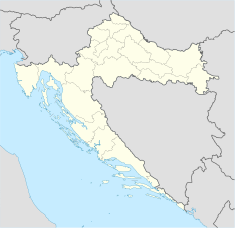Paklenica
| Paklenica National Park | |
|---|---|
|
Native name Croatian: Nacionalni park Paklenica |
|

Velika Paklenica
|
|
| Location |
Zadar County, |
| Coordinates | 44°22′N 15°26′E / 44.367°N 15.433°ECoordinates: 44°22′N 15°26′E / 44.367°N 15.433°E |
| Area | 95 km2 |
| Governing body | Paklenica National Park |
| Official name: Nacionalni park Paklenica | |
The Paklenica karst river canyon is a national park in Croatia. It is located in Starigrad, northern Dalmatia, at the southern slopes of Velebit mountain, not far from Zadar. It has two canyons: Mala (Small) and Velika (Big) Paklenica. Today there is no water flowing throughout Mala Paklenica. Near the entrance into the Velika Paklenica there is an artificial basement/cave complex that had been built for Josip Broz Tito during the tension between Yugoslavia and the USSR in the late 1940s and early 1950s.
The area of South Velebit has been inhabited since prehistoric times. It is believed that, during the last ice age, the area was probably inhabited by small groups of Paleolithic hunters/collectors, like elsewhere in the Mediterranean. The sea level must have been 120 metres lower than today at the time, and Velebit Channel was a wide valley with a river flowing through it. The highest parts of Velebit were covered with glaciers. When the sea level began to rise in the late ice age, people moved to higher, hilly areas. The earliest records of humans in Velebit – Mesolithic flint tools found in Vaganačka Cave under Veliko Rujno - date back to this era.
Approximately eight thousand years ago, the first cattle breeders and farmers arrived in the area, bringing wheat, domestic goats and sheep, as well as the knowledge of their breeding. The hunting/collection activities soon lost its importance, and a shepherd life began on Velebit. Plenty of material evidence, such as bones of domestic animals, tools and equipment used by prehistoric shepherds and decorated clay tableware, was found in the caves that served as shelter for people and cattle.
Over the last two thousand years BC, during the Bronze Age, the first fortifications and stone wall buildings were erected by Liburian peoples. They could serve as shelter to the population from the surrounding villages in case of danger, and some of them may have been permanent settlements where the local rulers had their seats. In addition, they oversaw important cattle and trade routes leading to Velebit and further to Lika via Paklenica or Rujan. Some of them served to oversee navigation. They are now destroyed, but ring-shaped mounds up to several meters in height can still be seen in some places. In immediate vicinity of the fortifications, you can find casket heaps – deposits of large round stone under which former rulers were buried in casket made of stone tablets. Most of them have been dug out and the graves have been robbed, but they can still be spotted here and there, like in the area of the village of Ljubotić above Tribanj-Kruščica.
...
Wikipedia

